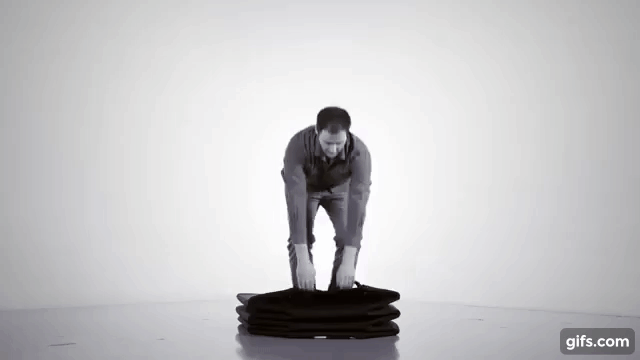Dusk for a Hitman
“Dusk for a Hitman” is a husk of a great film. Director Raymond St-Jean has a sturdy central character—though the crime drama is based on the real life of Montreal fixer Donald Lavoie, much of it is fictional—made stronger through a deft ability to conjure a grim atmosphere around an actor capable of landing emotional grace notes in a threadbare story. Contract killings are carried out with cold efficiency and continual negotiations of loyalty, and these basic mechanics are enough to breezily pass the time. But the film’s incuriosity of the cutthroat world inhabited by Lavoie and his fractured inner life restricts this foreboding character study, rendering it merely serviceable. Mostly taking place over the course of a year, “Dusk for a Hitman” begins in the Fall of 1979. Lavoie (Éric Bruneau), behind the wheel of his sleek caramel-colored Cadillac, is driving down a country road with a new, nervous partner. His young sidekick was assigned to Lavoie by their boss, Claude Dubois (Benoît Gouin), after the kid messed up a previous hit. Lavoie is accompanying him to finish the job. “Now that you have to help me, you’ll see it’s easy to kill a man,” Lavoie wryly says. The pair proficiently infiltrate the hideout of their target, shooting him in an outhouse. This is only half the task; in the quickness of a breath, Lavoie executes his partner. Lavoie is Dubois’ best hired gun. The real-life hitman, in fact, would later admit that he murdered fifteen people for the crime boss, who, with his mob boss brother—the film omits the sibling—ruled Montreal’s underworld. Along with killings, Lavoie also collects debts and is an enforcer. Dubois so trusts him that the kingpin even shows the hitman where to find his buried loot in case someone is dumb enough to take him hostage. Outside of the close bond shared by employer and employee, St-Jean and Martin Girard provide little else about this organization's inner workings. So, if you’re looking for Henry Hill to give a “Goodfellas” explanation of Lavoie’s background and personal thoughts, you won’t find it in this film. That isn’t necessarily a negative. I’d even say it’s by design: Dubois dispatches rats and failures so quickly there’s no sense in learning their names. But I can’t help but feel more world-building could have happened: What’s Dubois’ territory, and how does his business hum? There’s a similar thinness to Lavoie’s family life. His wife Francine (Rose-Marie Perreault) is so basic she might as well be nonexistent. His young daughter, to the best of my knowledge, doesn’t even have a name. Lavoie mostly calls her the kid. Once again, you get the sense this is by design. Not unlike what Martin Scorsese did with Anna Paquin’s character in “The Irishman.” Lavoie is so consumed by the lifestyle of murder, cocaine, and money—that he barely has the bandwidth or desire to see his family as people worth knowing. But by the second half of the film, when Lavoie’s motivations shift toward protecting his family, there are only two very brief scenes featuring his daughter. It’s a kind of hollowness that, after a while, feels less like a window into the character and more like a severed thread. Even the fraught relationship Lavoie shares with his screw-up of a brother leaves much on the table. The specter of an unseen abusive father, one sick with cancer, looms over their lives—to the point Lavoie sneers at the very mention of his dad. And yet, it’s a heartache perpetually gestured toward without ever being felt. The compositions in “Dusk for a Hitman” are fairly conventional (Bruneau is always centered framed), and the score has the kind of ragged, heavy guitars infiltrating just about every action film or crime thriller. Their simplicity, nevertheless, works in a film about an unsentimental killer whose soul is so blackened he can barely recognize himself. Even with the mostly staid lensing, some instances with a deep depth of field do ratchet up the atmosphere. When Lavoie is released from prison, you’re sure Dubois will whack him because of the sharp visual language. St-Jean and DP Jean-François Lord play with such expectations. Some simple blocking keeps a third gangster in view during an interrogation, and the staging of an ensuing hit holds the other hired guns just within reach, mulling behind Lavoie. St-Jean is lucky to have Bruneau. The lanky actor palpably flexes his frame from still and rigid in a run-up to a murder, kinetic during the actual deed, and frazzled when coked up. Even when the script keeps his character at arm’s length, Bruneau quietly brings us in. The strained rivalry between Lavoie and Detective Burns (Sylvain Marcel)—which later takes an unlikely turn—only works because of Bruneau’s talent for granting us access to Lavoie’s innermost hurts. The same could be said of the underwritten love Lavoie displays for his family. It’s Bruneau who makes you realize how great “Dusk for a Hitman” could have been if only it had some extra shine, but who also


“Dusk for a Hitman” is a husk of a great film. Director Raymond St-Jean has a sturdy central character—though the crime drama is based on the real life of Montreal fixer Donald Lavoie, much of it is fictional—made stronger through a deft ability to conjure a grim atmosphere around an actor capable of landing emotional grace notes in a threadbare story. Contract killings are carried out with cold efficiency and continual negotiations of loyalty, and these basic mechanics are enough to breezily pass the time. But the film’s incuriosity of the cutthroat world inhabited by Lavoie and his fractured inner life restricts this foreboding character study, rendering it merely serviceable.
Mostly taking place over the course of a year, “Dusk for a Hitman” begins in the Fall of 1979. Lavoie (Éric Bruneau), behind the wheel of his sleek caramel-colored Cadillac, is driving down a country road with a new, nervous partner. His young sidekick was assigned to Lavoie by their boss, Claude Dubois (Benoît Gouin), after the kid messed up a previous hit. Lavoie is accompanying him to finish the job. “Now that you have to help me, you’ll see it’s easy to kill a man,” Lavoie wryly says. The pair proficiently infiltrate the hideout of their target, shooting him in an outhouse. This is only half the task; in the quickness of a breath, Lavoie executes his partner.
Lavoie is Dubois’ best hired gun. The real-life hitman, in fact, would later admit that he murdered fifteen people for the crime boss, who, with his mob boss brother—the film omits the sibling—ruled Montreal’s underworld. Along with killings, Lavoie also collects debts and is an enforcer. Dubois so trusts him that the kingpin even shows the hitman where to find his buried loot in case someone is dumb enough to take him hostage. Outside of the close bond shared by employer and employee, St-Jean and Martin Girard provide little else about this organization's inner workings. So, if you’re looking for Henry Hill to give a “Goodfellas” explanation of Lavoie’s background and personal thoughts, you won’t find it in this film. That isn’t necessarily a negative. I’d even say it’s by design: Dubois dispatches rats and failures so quickly there’s no sense in learning their names. But I can’t help but feel more world-building could have happened: What’s Dubois’ territory, and how does his business hum?
There’s a similar thinness to Lavoie’s family life. His wife Francine (Rose-Marie Perreault) is so basic she might as well be nonexistent. His young daughter, to the best of my knowledge, doesn’t even have a name. Lavoie mostly calls her the kid. Once again, you get the sense this is by design. Not unlike what Martin Scorsese did with Anna Paquin’s character in “The Irishman.” Lavoie is so consumed by the lifestyle of murder, cocaine, and money—that he barely has the bandwidth or desire to see his family as people worth knowing. But by the second half of the film, when Lavoie’s motivations shift toward protecting his family, there are only two very brief scenes featuring his daughter. It’s a kind of hollowness that, after a while, feels less like a window into the character and more like a severed thread.
Even the fraught relationship Lavoie shares with his screw-up of a brother leaves much on the table. The specter of an unseen abusive father, one sick with cancer, looms over their lives—to the point Lavoie sneers at the very mention of his dad. And yet, it’s a heartache perpetually gestured toward without ever being felt.
The compositions in “Dusk for a Hitman” are fairly conventional (Bruneau is always centered framed), and the score has the kind of ragged, heavy guitars infiltrating just about every action film or crime thriller. Their simplicity, nevertheless, works in a film about an unsentimental killer whose soul is so blackened he can barely recognize himself. Even with the mostly staid lensing, some instances with a deep depth of field do ratchet up the atmosphere. When Lavoie is released from prison, you’re sure Dubois will whack him because of the sharp visual language. St-Jean and DP Jean-François Lord play with such expectations. Some simple blocking keeps a third gangster in view during an interrogation, and the staging of an ensuing hit holds the other hired guns just within reach, mulling behind Lavoie.
St-Jean is lucky to have Bruneau. The lanky actor palpably flexes his frame from still and rigid in a run-up to a murder, kinetic during the actual deed, and frazzled when coked up. Even when the script keeps his character at arm’s length, Bruneau quietly brings us in. The strained rivalry between Lavoie and Detective Burns (Sylvain Marcel)—which later takes an unlikely turn—only works because of Bruneau’s talent for granting us access to Lavoie’s innermost hurts. The same could be said of the underwritten love Lavoie displays for his family. It’s Bruneau who makes you realize how great “Dusk for a Hitman” could have been if only it had some extra shine, but who also allows you to be content that St-Jean’s crime movie is merely a sturdy installment in the genre.



















